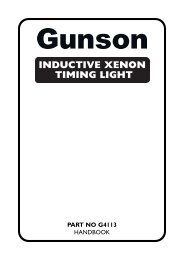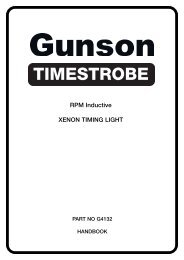POCKETMETER 2 - Gunson
POCKETMETER 2 - Gunson
POCKETMETER 2 - Gunson
Create successful ePaper yourself
Turn your PDF publications into a flip-book with our unique Google optimized e-Paper software.
<strong>Gunson</strong> Timestrobe<br />
be used for supplies at 50 and 60 Hz, and 110V and 250VAC respectively.<br />
Great care should be exercised in making any high voltage measurements, ie measurements<br />
made using the 0 to 200V DC range, or the 0 to 750V AC range, because of the potentially serious<br />
consequences of high voltage shocks to the user. When measuring high voltages, such as<br />
domestic mains voltage, great care should be taken to avoid electric shock.<br />
All DC voltage ranges have a very high internal impedance (about 1 meg-ohms), which means<br />
that Pocketmeter draws a negligibly small current from the circuit being tested. Therefore the<br />
circuit is not affected by connecting Pocketmeter to it, and Pocketmeter can be used on sensitive<br />
electronic circuits. This high internal impedance of Pocketmeter also provides protection to<br />
Pocketmeter. On VOLTS AC, the internal impedance (resistive) is 450 K-ohms.<br />
Measuring voltage is a simple matter, the probes of the meter are simply touched on the two<br />
points of the circuit which are of interest, and between which the voltage is to be measured.<br />
That is, voltage measurements are always made with the leads connected IN PARALLEL with the<br />
circuit or component being tested.<br />
INSTRUCTIONS FOR USE (VOLTAGES BELOW 20 V DC OR AC)<br />
(a) Set the central FUNCTION switch to the appropriate voltage range (V DC) or<br />
V AC). Set to a high range initially. The range can be switched lower if greater accuracy is<br />
required.<br />
(b) Fit the RED and BLACK leads to the middle (V) and COM sockets. Touch the RED and<br />
BLACK leads across the circuit or component to be tested. RED should be connected to the<br />
positive side, and BLACK to the negative side for DC measurements.<br />
(c) Observe the reading on the display. If the connections have been made the wrong way<br />
round Pocketmeter will simply show a minus sign in front of the reading (DC measurements).<br />
(d) After use, disconnect the leads from the circuit being measured BEFORE returning the<br />
FUNCTION switch to the OFF position. (NEVER rotate the FUNCTION switch through OHMS or<br />
AMPS position with the leads connected to a LIVE voltage).<br />
INSTRUCTIONS FOR USE (VOLTAGES ABOVE 20 V, INCLUDING 230 or 110 V AC).<br />
High voltages are dangerous, and mains electric shocks can be fatal. For use in measurement of<br />
high voltages, follow the instructions for voltage measurements above, but take particular care to<br />
avoid any possibility of electric shocks. Make all contacts with live parts using the insulated<br />
probes, keeping fingers well away from the exposed metal parts of the probes.<br />
The user should ensure that the leads are well plugged into the sockets, and that the leads are<br />
not chafed or damaged, and that the case of Pocketmeter has not been cracked or damaged.<br />
Needless to say, such measurements should not be made while the case of Pocketmeter is open.<br />
Note that if high voltages, including main supply voltages, are applied to Pocketmeter while the<br />
Function switch is set to CONTINUITY, DIODE, or any of the OHMS ranges, there is the possibility<br />
of meter circuit damage. Such misuse voids The Tool Connection<br />
6

















